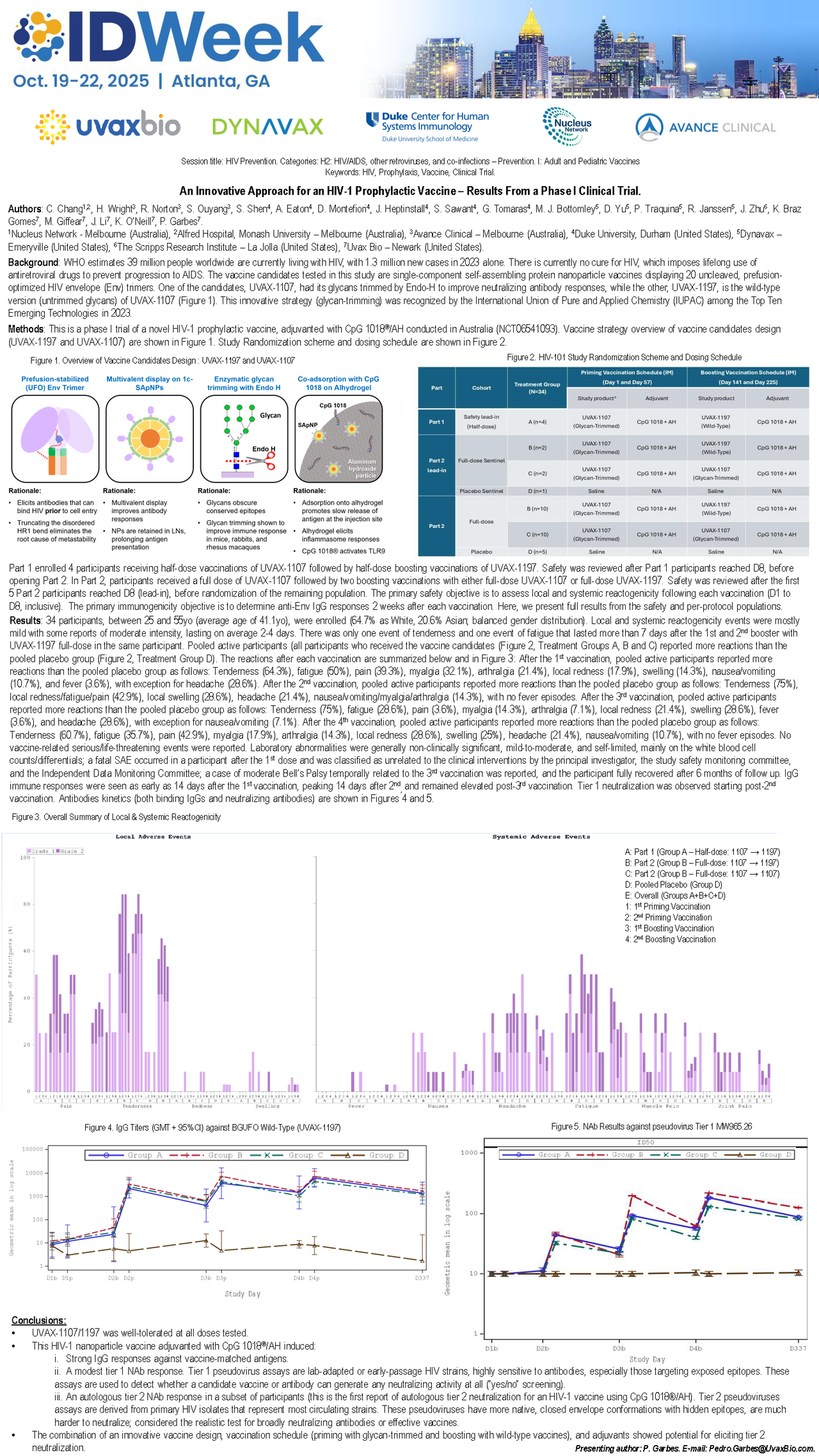HIV remains a significant global health challenge, with the World Health Organization estimating that 39 million people are currently living with the virus and 1.3 million new cases emerging in 2023 alone. The absence of a cure necessitates lifelong antiretroviral therapy, highlighting the urgent need for an effective prophylactic vaccine. At ID Week 2025, held in Atlanta, GA, on October 20, 2025, researchers unveiled promising results from a Phase I clinical trial that tested innovative vaccine candidates designed to combat HIV-1. Among these candidates, UVAX-1107, featuring glycans trimmed through a unique technique, demonstrated enhancements in neutralizing antibody responses, potentially paving the way for breakthroughs in HIV prevention.
The Phase I clinical trial's outcomes signify a crucial step forward in HIV vaccine development and underscore the importance of novel strategies like glycan-trimming. This method not only received recognition from the International Union of Pure and Applied Chemistry (IUPAC) as one of the Top Ten Emerging Technologies in 2023, but it also exemplifies a transformative approach in the quest for effective HIV prophylaxis. As we delve deeper into these findings, we will explore the implications of this cutting-edge research and its potential to reshape the future of HIV prevention.
Innovative HIV-1 vaccine development presented at ID Week 2025 in Atlanta, GA
The fight against HIV-1 has seen promising advancements, especially with the results from a groundbreaking Phase I clinical trial presented at ID Week 2025 in Atlanta, GA, on October 20, 2025. This trial focused on two innovative vaccine candidates: UVAX-1107 and UVAX-1197. Both vaccines utilize a cutting-edge approach that incorporates single-component self-assembling protein nanoparticle technology to display HIV envelope (Env) trimers. By leveraging these advanced formulations, researchers aim to stimulate robust immune responses that can effectively combat HIV.
The significance of this research cannot be understated, as WHO reports indicate that 39 million people worldwide are currently living with HIV, highlighting the urgent need for effective prevention strategies. Presenting these results at ID Week 2025 underscores the collective effort of the scientific community to develop a viable prophylactic vaccine against HIV-1. The innovative strategies employed in this clinical trial not only pave the way for future research but also provide hope for millions affected by the virus, demonstrating that groundbreaking solutions are on the horizon.
Breakthrough results from phase I clinical trial and their implications
The results from the Phase I clinical trial of the innovative HIV-1 prophylactic vaccines, UVAX-1107 and UVAX-1197, mark a significant advance in the pursuit of an effective HIV vaccine. These candidates demonstrated a robust immune response, particularly with the glycan-trimming approach used in UVAX-1107, which enabled enhanced neutralizing antibody production. Participants receiving this vaccine candidate exhibited higher levels of specific antibodies that can target HIV-1 effectively, highlighting the potential of this strategy in reshaping how we approach HIV prevention. The data collected during this trial showed promising safety profiles, with no severe adverse effects reported, allowing researchers to consider advancing to larger studies.
The implications of these findings extend beyond just this trial. With WHO estimating that 39 million individuals are currently living with HIV, the successful development of a prophylactic vaccine could drastically change the landscape of HIV prevention globally. The promising immune responses observed in this trial signal that further exploration into glycan-trimming and self-assembling protein nanoparticle vaccines may unlock new pathways for vaccine development. By improving neutralizing antibody responses, researchers can potentially reduce the burden of HIV globally and limit new infections, ultimately moving us closer to the dream of eradicating HIV/AIDS entirely.
Glycan-trimming: A game-changing strategy in HIV prophylaxis
Glycan-trimming is an innovative approach that has the potential to significantly enhance the efficacy of HIV-1 vaccines. By modifying the glycan structures on the HIV envelope proteins, researchers can increase the immunogenicity of the vaccine candidates, making them more effective at eliciting strong neutralizing antibody responses. In the trial, UVAX-1107—with its glycans trimmed by Endo-H—demonstrated improved interaction with the immune system compared to its wild-type counterpart, UVAX-1197. This optimization allows for a more robust targeting of the HIV virus, paving the way for more effective prophylactic measures against HIV infection.
The implications of this glycan-trimming technique extend beyond just immediate vaccine responses. By prioritizing the presentation of prefusion-optimized HIV envelope trimers, researchers can also harness the body's natural immune mechanisms, potentially leading to long-lasting protection against HIV. The recognition of this strategy by the International Union of Pure and Applied Chemistry (IUPAC) as one of the Top Ten Emerging Technologies in 2023 highlights its significance and promise in the ongoing fight against HIV. As this groundbreaking strategy gains traction, it opens new avenues for research and development, ultimately bringing us closer to a viable prophylactic vaccine against HIV.
